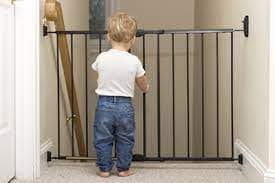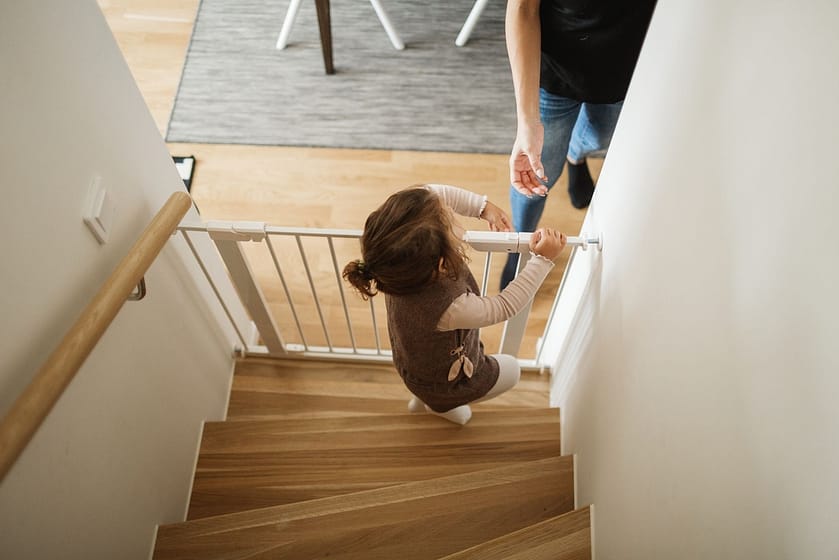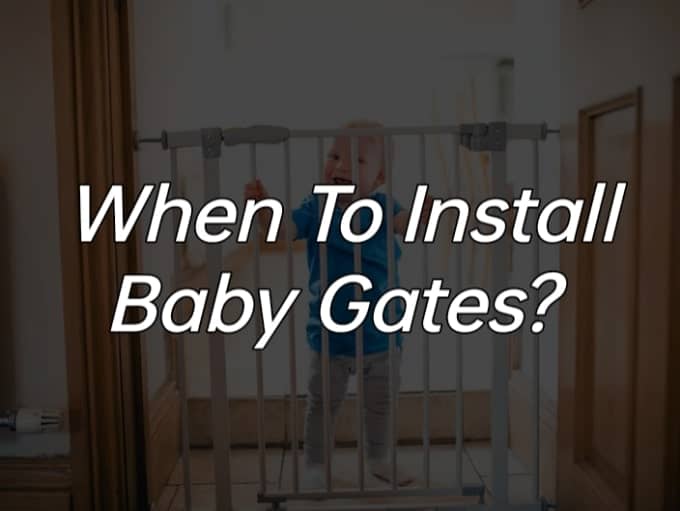Table of Contents
ToggleWelcoming a new baby into your home is a joyous occasion filled with anticipation and preparation. Among the many necessities for ensuring your child’s safety, knowing when to install baby gates is paramount.
As these little explorers start to crawl and walk, baby gates become essential barriers that protect them from potential dangers, making your home a secure playground.
When to Install Baby Gates? Short answer.
Short Answer
You should install baby gates when your baby starts to show signs of mobility, typically between 6 to 10 months of age.
Full Answer
Ensuring your home is baby-ready involves the timely installation of baby gates, a significant milestone that commonly aligns with your baby’s increasing mobility. This usually occurs between 6 to 10 months of age, when most babies begin to crawl.
However, every child is unique, and some may start their crawling adventures earlier or later. It’s wise to stay observant of your little one’s development and install the gates as soon as crawling or cruising begins.
By being proactive, you ensure that your home is a safe haven for your ever-curious baby. Remember, it’s not just about staircases; consider installing gates to secure kitchens, bathrooms, or any area with potential hazards.
Introducing Baby Gates - What Are They and When Should You Consider Installing Them:
Baby gates, also known as child safety gates, are barriers designed to prevent babies from accessing areas of your home where they might encounter potential hazards.
These could include stairs, kitchens filled with sharp objects and hot surfaces, bathrooms with slippery floors, or any room with delicate or potentially dangerous items.
The right time to install baby gates largely depends on when your child begins to show signs of mobility. While this typically occurs between the ages of 6 to 10 months, some babies may begin to crawl earlier or later.
As a parent, it’s essential to be observant of your child’s developmental milestones and install baby gates once they start showing mobility signs like crawling, pulling themselves up, or cruising (walking while holding onto furniture).
Consider the following points when planning the installation of baby gates:
- Early Installation: It’s never too early to install baby gates. Some parents choose to install them before their baby is born or soon after. This allows parents to get used to the gates’ presence and operation before they actually need them.
- Securing High-Risk Areas: Prioritize areas that pose the highest risk to your child. This includes staircases, kitchens, and bathrooms. It’s also advisable to secure rooms with heavy furniture or equipment that could tip over if a baby were to grab hold.
- Quality and Safety Standards: Always choose baby gates that meet safety standards. Look for a seal from an accredited organization, which assures that the gate has been tested for safety and durability.
- Proper Installation: A baby gate is only as safe as its installation. Make sure it’s securely installed and can’t be easily pushed down.
- Regular Checks: Regularly check the gates to ensure they are secure and functioning as intended. Babies grow and become stronger, and a gate that was once secure might not be after a few months.
Remember, baby gates are not a substitute for adult supervision. They are a helpful tool in your child’s safety arsenal, allowing you to have peace of mind as your little one begins to explore their world.
Do I Need a Baby Gate for Every Room in My Home or Just the Stairs and Hallways?
When deciding where to install baby gates in your home, it’s essential to consider not just the high-risk areas, but also the zones where your child spends the most time. Here’s a detailed answer to guide you:
- Identifying High-Risk Areas: The staircases, kitchens, and bathrooms are undoubtedly high-risk areas. These spaces often contain hard surfaces, sharp corners, and, in the case of kitchens, potentially dangerous appliances.
- Rooms with Frequent Child Access: Areas where your child frequently plays or moves around, such as the living room or their own bedroom, should also have baby gates. This helps confine them to a safe, supervised area.
- Rooms with Potentially Hazardous Items: Any room with furniture or objects that could potentially harm your child, like electronics, sharp objects, or heavy items that could tip over, should be gated as well.
- Home Office or Workspaces: If you have a home office or a workshop within your home, it’s crucial to install a baby gate. These areas often have equipment, cords, or small items that could be hazardous for a curious child.
- Outdoors Areas: If your home has a patio, a deck, or a backyard, consider installing a gate to prevent your child from wandering into these areas unsupervised.
Remember, while baby gates are a valuable tool in ensuring your child’s safety, they are not a replacement for attentive care and supervision. Constant vigilance is the best way to ensure your little one stays safe as they explore their surroundings.
Safety Tips for Installing a Baby Gate - Who Should Install It and The Best Placement
Installing a baby gate is typically a task that anyone can undertake, provided they follow safety guidelines and instructions carefully.
However, if there are complexities involved like attaching the gate to a banister or requiring additional tools, you might want to consider hiring a professional to ensure the gate is installed securely and correctly.
For the best placement, baby gates should ideally be installed at the top and bottom of staircases, doorways to high-risk rooms like kitchens and bathrooms, and other areas where your child frequents.
It’s imperative to ensure that the gate is level, securely fastened, and not easily pushed down or manipulated by your little one.
For detailed instructions on how to install baby gates safely, you may refer to this guide. Furthermore, to gain insights on the best places to install baby gates in your home according to your specific needs, check out this article.
Consider Safety When Installing Baby Gates:
When installing baby gates, it’s crucial to take into account the following considerations:
- Height of the Gate: The gate’s height should be such that your child cannot climb over it. As a rule of thumb, a gate should be at least three-quarters of your child’s height.
- Spacing Between Bars: The bars of the gate should be close enough to prevent your child from squeezing through or getting stuck. Aim for spacing of no more than three inches.
- Latch Mechanism: Choose a gate with a complex latch mechanism that your child won’t be able to figure out. At the same time, it should be easy for adults in the house to open and close.
- Type of Gate: There are two types of gates – hardware-mounted gates that attach to the walls with screws, and pressure-mounted gates that stay in place with tension. Hardware-mounted gates are more secure and should be used at the top of the stairs.
- Gate Material: Ensure the gate is made of sturdy, non-toxic material. Avoid older, second-hand gates that might not meet current safety standards.
It’s important to remember that while baby gates can provide an extra layer of safety, they are not a substitute for adult supervision. Always keep an eye on your child to ensure they are safe.
Are You Ready to Install a Baby Gate in Your Home Now or Later On in Life?

Deciding the Right Time to Install a Baby Gate
The question of when to install a baby gate is ultimately a personal decision that depends on your child’s development and the unique characteristics of your home. However, a general guideline is to install baby gates once your child shows signs of mobility, usually starting from 6 months onwards. Remember, it’s always better to be safe than sorry, so early installation is recommended even before your baby starts to crawl or walk.
Considering Multiple Baby Gates for Increased Safety
While one might think installing a single gate is sufficient, it’s crucial to note that multiple gates could provide an additional layer of safety. Installing a baby gate at the top and bottom of staircases, and at the entrances of rooms with potential hazards, can significantly enhance your child’s safety and give you peace of mind.
If you want to know: how many baby gates do you need?
Regular Maintenance and Checks: Ensuring Baby Gate Effectiveness
Regular maintenance checks are key to ensuring your baby gates are still functioning properly and remain secure. Over time, wear and tear could compromise the effectiveness of the gate, or your growing child may learn to tamper with it. Regular checks and timely replacements or adjustments are essential to maintain the safety of your child.
Making Sure Your Child is Secure Around the House - What Else Can You Do Besides Installing a Baby Gate:

While baby gates significantly contribute to safeguarding your child from potential hazards, they are just one element of a comprehensive childproofing strategy. Here are a few additional steps you can take to ensure your child’s safety at home:
- Corner Protectors: Installing corner protectors on furniture with sharp edges can prevent injuries from falls or bumps.
- Outlet Covers: Electric outlets are often at a baby’s eye level and can be fascinating to little fingers. Using outlet covers can protect your child from potential electrical hazards.
- Anti-Slip Mats: Using anti-slip mats under rugs and in wet areas like bathrooms can prevent slips and falls.
- Secure Furniture: Anchor heavy furniture, like bookcases and TVs, to the wall to prevent them from tipping over.
- Safety Locks: Use safety locks on cabinets and drawers, especially those containing cleaning supplies, cosmetics, medications, or sharp objects.
Remember, childproofing is a dynamic process that changes as your child grows and their exploratory abilities evolve.
Regular revisiting and updating of your childproofing measures is essential to maintain a safe environment for your child.
Ultimately, the most effective safety measure is your watchful supervision and loving care.
Conclusion:
The importance of baby gates in ensuring the safety of your mobile child cannot be overstated. It’s crucial to install these gates at the right time – typically when your child starts showing signs of mobility around six months of age.
In installation, you need to consider the right height, bar spacing, latch mechanism, gate type, and material to afford the best protection. Regular maintenance checks are important to ensure the gates continue to serve their purpose effectively.
Even though baby gates serve as a critical safety measure, they should be complemented with other childproofing strategies like corner protectors, outlet covers, anti-slip mats, securing furniture, and safety locks.
Lastly, despite all these measures, nothing replaces the importance of constant adult supervision. The safety of your child is a dynamic and ongoing process, evolving with your baby’s growth and exploration. Stay alert, stay vigilant, and stay safe.



4 thoughts on “When to Install Baby Gates?”